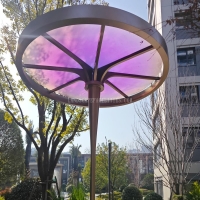Welcome to the website for landscape facilities products and knowledge.
How does the table’s design enhance airflow to prevent heat buildup in sunny conditions?
When selecting outdoor furniture for sun-drenched spaces, the table's architectural design plays a crucial role in temperature regulation. Unlike solid surfaces that absorb and trap thermal energy, advanced tables incorporate strategic ventilation systems directly into their structure. These designs typically feature perforated tabletops with precisely calculated aperture patterns that create continuous air channels. As sunlight strikes the surface, these openings permit ambient air to circulate beneath objects and across the table plane, facilitating convective heat transfer.
The geometry of support elements further enhances this cooling effect. Rather than using solid pedestals or wide legs that block air movement, engineered designs employ open frameworks, slender profiles, or angled components that minimize surface area while maintaining structural integrity. This approach creates unobstructed air pathways around the entire table assembly, allowing breezes to carry accumulated heat away from critical contact points.
Some manufacturers incorporate double-layered surfaces with hidden ventilation gaps or integrate heat-dissipating materials with thermal reflective properties. These sophisticated designs work in tandem with airflow channels to create a comprehensive cooling system. The result is a table surface that remains significantly cooler than conventional designs—sometimes by margins of 15-20°F—even after hours of direct sun exposure. This intelligent engineering transforms ordinary outdoor furniture into climate-responsive installations that prioritize comfort through physics rather than just material selection alone.
Related search:

Recommendation
Metal frame with gradient color acrylic combined with high-end shading landscape facilities